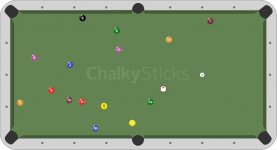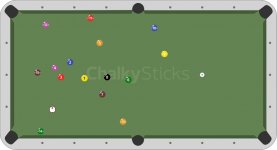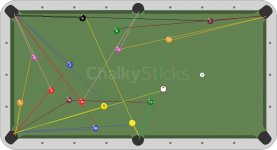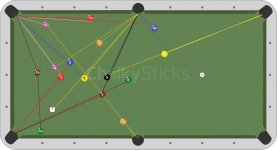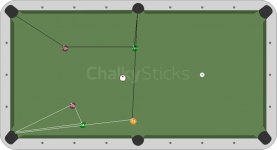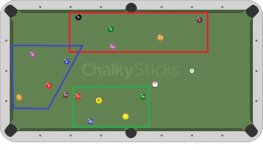@Jeff:
I understand you are using these diagrams to illustrate what is possible, if not practical. This looks like a good method when there are 5 or 6 balls on the table to see if any good stop shot patterns are available.
I took your first diagram as an opportunity to say how I would approach this table. See diagram below.
After recognizing that my opponent has managed to sell out in an epic way

I choose the 15 as the break ball. I'm looking for problem areas and noting that the 7 is going to cause me to travel more than I'd like, and the 10 needs to be played carefully. The 8 on the rail is fine because it gives me an easy path to the 9. The 11 is uncomfortably close to the break ball, but it passes to both corner pockets, so isn't too bad.
Next, I'm observing that I can create a triangle of ball clusters, outlined in colors below. It isn't generally good to have balls below the break ball, so I want to clear the blue clustered balls first. Clearing the red cluster next will set me up for the third leg of the triangle, the green balls.
At this point I know there are no real problem balls, but I want to have an idea of how I am going to get from one group of balls to the next, and what my first shot is going to be. The 14 is the easiest shot to get started, and a stun shot puts me onto the 2 ball so that I can get started on the blue group. If I get straight on the 11 I am going to shoot it in the corner before I shoot the 2 and draw back a tad for the 2. I just don't like to have that 11 so close to my break ball for the end pattern.
I still haven't hit a ball, but I'm realizing that I'll be shooting either the 6 or 12 as my transition from the blue to the red group. All I need to know about the red group is that I want the 8 to be my transition to the green group because I have an easy shot on the 9 from the 8. At that point I'll just have stop-stop on the 10 and 1 balls to finish the rack. I like thinking about 2 key balls near each other rather than just one. This is something I observed from a Danny Harriman video. Having a "second" key ball allows you to fine tune the break ball angle. I've used this idea with good results.
Just wanted to throw that out there...
